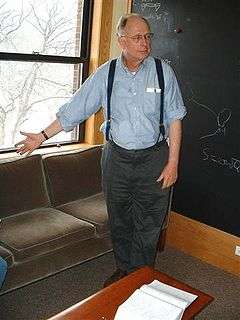James Hartle
James Burkett Hartle (August 20, 1939) is an American physicist. He has been a professor of physics at the University of California, Santa Barbara since 1966, and he is currently a member of the external faculty of the Santa Fe Institute. Hartle is known for his work in general relativity, astrophysics, and interpretation of quantum mechanics.
James B. Hartle | |
|---|---|
 Jim Hartle at Harvard University. | |
| Born | James Burkett Hartle 20 August 1939 |
| Nationality | American |
| Citizenship | United States |
| Alma mater | California Institute of Technology |
| Scientific career | |
| Fields | General relativity Astrophysics Quantum mechanics |
| Institutions | University of California, Santa Barbara Santa Fe Institute |
Work
In collaboration with Murray Gell-Mann and others, Hartle developed an alternative to the standard Copenhagen interpretation, more general and appropriate to quantum cosmology, based on consistent histories.
With Dieter Brill in 1964, he discovered the Brill–Hartle geon, an approximate solution realizing Wheeler's suggestion of a hypothetical phenomenon in which a gravitational wave packet is confined to a compact region of spacetime by the gravitational attraction of its own field energy.[1]
With Kip Thorne, Hartle derived from general relativity the laws of motion and precession of black holes and other relativistic bodies, including the influence of the coupling of their multipole moments to the spacetime curvature of nearby objects,[2] as well as writing down the Hartle-Thorne metric, an approximate solution which describes the exterior of a slowly and rigidly rotating, stationary and axially symmetric body.
Working at the Enrico Fermi Institute at the University of Chicago in 1983, he developed the Hartle–Hawking wavefunction of the Universe in collaboration with Stephen Hawking. This specific solution to the Wheeler–deWitt equation is meant to explain the initial conditions of the Big Bang cosmology.
Hartle is the author of the textbook on general relativity entitled Gravity: an Introduction to Einstein's General Relativity.[3]
References
- Brill, D. R.; Hartle, J. B. (1964). "Method of the Self-Consistent Field in General Relativity and its Application to the Gravitational Geon". Phys. Rev. 135 (1B): B271–B278. Bibcode:1964PhRv..135..271B. doi:10.1103/PhysRev.135.B271.
- Hartle, James; Thorne, Kip S. (1985). "Laws of motion and precession for black holes and other bodies" (PDF). Physical Review D. 31 (8): 1815–1837. Bibcode:1985PhRvD..31.1815T. doi:10.1103/PhysRevD.31.1815.
- Hartle, James B. (2003). Gravity: an Introduction to Einstein's General Relativity. San Francisco: Addison–Wesley. ISBN 0-8053-8662-9.,
External links
- James Hartle homepage
- Faculty profile
- "The Future of Gravity" – April, 2000 online lecture (RealAudio plus slides)
- "Spacetime Quantum Mechanics" online RealAudio lecture
- "The Classical Behavior of Quantum Universes" online RealAudio lecture
- James Hartle at the Mathematics Genealogy Project